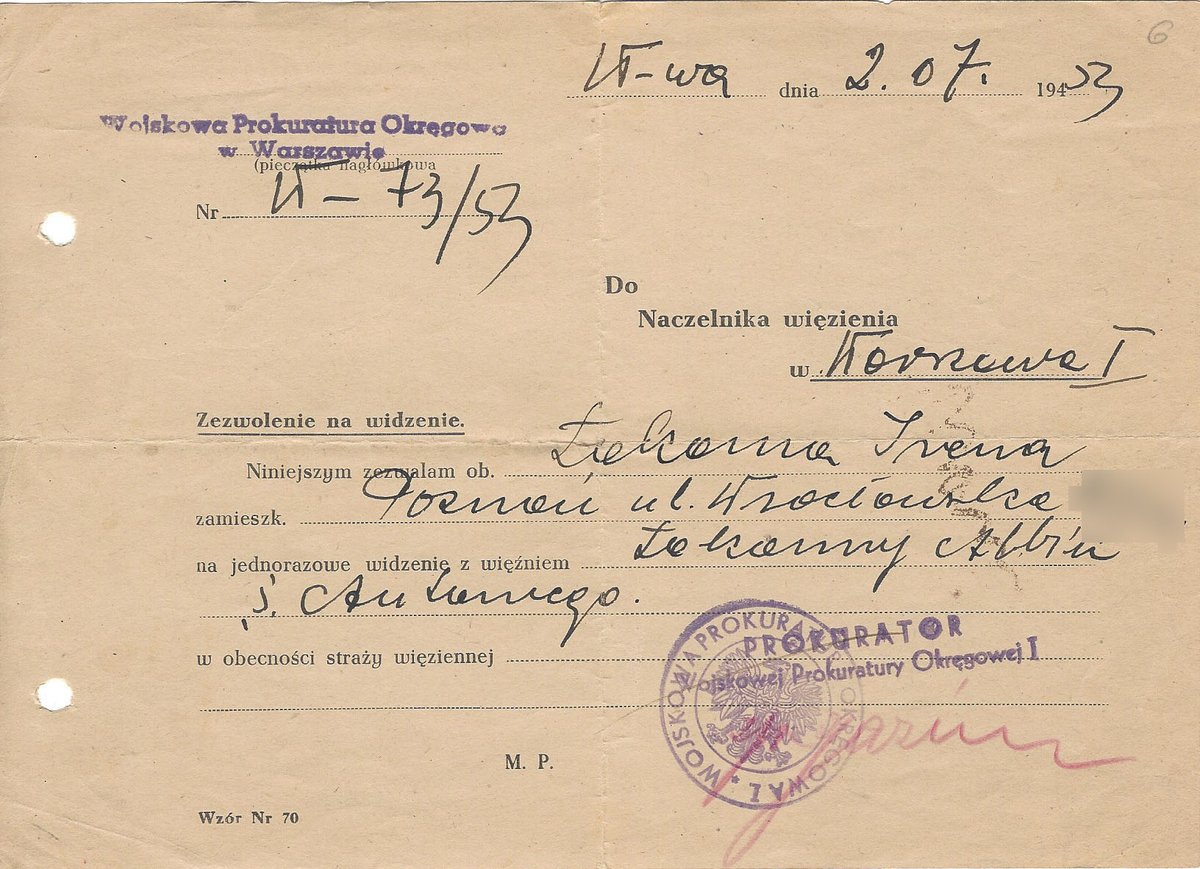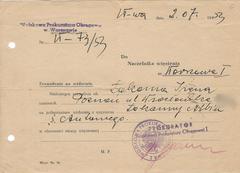
Mokotów Prison Warsaw: Visiting Hours, Tickets, and Visitor Guide
Date: 03/07/2025
Introduction
Mokotów Prison, known locally as Więzienie Mokotowskie or Rakowiecka Prison, stands as one of Warsaw’s most significant historical landmarks. Its somber walls embody the complexity of Poland’s 20th-century history, having served as a tool of repression under Russian, Nazi, and communist regimes. Today, Mokotów Prison is open to the public as a place of remembrance, education, and reflection, offering insight into the struggles and resilience of the Polish people. This guide provides detailed information on the prison’s history, visiting logistics, ticketing, accessibility, and nearby attractions to help you plan a respectful and enriching visit. For the most current updates, consult official resources such as the Institute of National Remembrance (IPN) and the Warsaw Uprising Museum. (Kuryer Polski, Historical Sites, Wikipedia)
Table of Contents
- Introduction
- History of Mokotów Prison
- Visiting Mokotów Prison
- Memorialization and Cultural Significance
- Nearby Attractions in Warsaw
- Visitor Experience and Code of Conduct
- Frequently Asked Questions (FAQ)
- Conclusion and Final Tips
- References
History of Mokotów Prison
Tsarist Foundations and the Interwar Period
Constructed between 1902 and 1904 during the Russian partition, Mokotów Prison was initially designed to suppress Polish nationalist movements and serve as a high-security penitentiary. Following Poland’s independence in 1918, the prison was modernized and became the principal detention facility for the Polish attorney general’s office, functioning primarily as a criminal prison throughout the interwar years. (Kuryer Polski, Wikipedia)
World War II: Nazi Occupation and Atrocities
With the Nazi occupation of Poland in 1939, Mokotów Prison was seized by German authorities and became infamous for the detention, torture, and execution of resistance members, intellectuals, and civilians. The facility witnessed countless atrocities, and during the 1944 Warsaw Uprising, a Home Army unit managed to briefly liberate about 300 inmates before the SS retook control. (Historical Sites)
The Stalinist Era and Beyond
After World War II, Mokotów Prison continued as a site of political repression, this time under the communist regime. Many anti-communist activists, soldiers of the Polish Underground State, and intellectuals were incarcerated, tortured, and executed here, making the prison a symbol of Poland’s suffering and resilience. Today, the preserved prison serves as a memorial and museum under the stewardship of the Institute of National Remembrance (IPN).
Visiting Mokotów Prison
Visiting Hours and Tickets
- Opening Hours: Typically Tuesday to Sunday, 10:00 AM–5:00 PM (last admission at 4:30 PM). Closed Mondays and public holidays. Some areas may require advance booking, especially during commemorative events.
- Tickets: Standard admission is 20 PLN, with concessions for students, seniors, and groups. Guided tours (in Polish and English) may require advance reservation. Admission to memorial areas is generally free, but group tours should be arranged in advance.
For the most up-to-date hours and booking procedures, confirm via the IPN website.
Location and How to Get There
- Address: 37 Rakowiecka Street, Mokotów district, Warsaw.
- Public Transport:
- Metro: Racławicka Station (Line M1), about a 10-minute walk.
- Bus/Tram: Numerous lines stop along Rakowiecka Street.
- By Car: Limited street parking; public transport is recommended for convenience.
For Warsaw public transport info and ticketing, see ZTM Warsaw.
Accessibility
The prison’s historic architecture means that while some areas have been adapted for wheelchair access and there are accessible restrooms, not all parts are barrier-free. Visitors with mobility needs should contact the administration in advance to discuss specific requirements.
Guided Tours and Virtual Experiences
- Guided Tours: Offer detailed historical context and access to areas not open to self-guided visitors. Tours last approximately 60–90 minutes and are available in Polish and English. Advance booking is strongly advised.
- Virtual Tours: For those unable to visit in person, virtual tours with 360-degree views and narrated histories are available via official websites.
Memorialization and Cultural Significance
Mokotów Prison is not only a historical site but a living memorial. Key spaces, such as the preserved execution chamber (“Death Row”), original cells, and commemorative plaques, bear witness to the suffering endured here. Annual commemorations (notably on August 1st, marking the Warsaw Uprising, and February 1st, honoring victims of Stalinist terror) draw survivors, families, and the public to honor those lost. Educational initiatives—lectures, exhibitions, and survivor testimonies—underscore the prison’s role in Poland’s collective memory and ongoing dialogue about freedom and justice. (Warsaw Uprising Museum, Historical Sites, IPN)
Nearby Attractions in Warsaw
Combine your visit to Mokotów Prison with other significant sites in Warsaw to deepen your understanding of the city’s history:
- Warsaw Uprising Museum: Chronicling the 1944 uprising against Nazi occupation.
- POLIN Museum of the History of Polish Jews: Exploring centuries of Jewish life in Poland.
- Łazienki Park: Home to palaces, monuments, and tranquil gardens.
- Museum of Polish Military Technology and Królikarnia Palace and Sculpture Museum: Showcasing Warsaw’s diverse cultural heritage.
- Mokotów Parks: Park Morskie Oko and Park Arkadia offer peaceful spaces for reflection.
For more neighborhood insights, see Fodor’s Travel.
Visitor Experience and Code of Conduct
- Entry Procedures: Arrive 15–30 minutes before your scheduled tour for security screening. Bags are inspected; large bags or luggage are not permitted. Bring valid ID for entry.
- Site Etiquette: Out of respect for the memory of victims, maintain a solemn demeanor, dress modestly, and avoid disruptive behavior. Photography is allowed in most areas but restricted in some sensitive sections.
- Children: Due to the site’s sensitive content, children under 14 are not recommended to visit.
- Amenities: Basic facilities such as restrooms and an information desk are available. Cafés, restaurants, and shops are located nearby in the Mokotów district.
Frequently Asked Questions (FAQ)
Q: What are Mokotów Prison’s visiting hours?
A: Tuesday to Sunday, 10:00 AM–5:00 PM; closed Mondays and public holidays. Check for changes before visiting.
Q: How can I buy tickets?
A: Tickets are available online via the official site or at the entrance. Advanced booking is recommended for guided tours.
Q: Are guided tours available in English?
A: Yes, tours are offered in Polish and English; other languages may be arranged with prior notice.
Q: Is the prison accessible for visitors with disabilities?
A: Some sections are accessible; contact the administration in advance to discuss your needs.
Q: Can I take photographs inside?
A: Photography is permitted in most areas except those marked as restricted.
Q: How do I get there using public transport?
A: Use Metro Line M1 to Racławicka Station or nearby bus/tram lines; see ZTM Warsaw.
Conclusion and Final Tips
Mokotów Prison stands as a powerful testament to Poland’s enduring quest for freedom and justice. Visiting this site provides a meaningful opportunity to reflect on Warsaw’s turbulent history and honor the memory of those who suffered and resisted. To ensure a respectful and informative visit:
- Plan ahead: Confirm current hours and book tours early, especially during commemorative periods.
- Prepare for emotional impact: The exhibits and stories are intense and deeply moving.
- Take time to explore: Pair your visit with nearby museums and parks to enrich your understanding of Warsaw’s history and culture.
For more in-depth guidance and audio tours of Mokotów Prison and other historical sites, download the Audiala app. Stay connected via social media for the latest updates and event announcements.
By visiting and engaging respectfully with Mokotów Prison, you help preserve the memory of those who endured unimaginable hardship and contribute to a broader understanding of Poland’s past and its lessons for the future.
References and Official Sources
- Mokotów Prison: Visiting Hours, Tickets, and History of Warsaw’s Historic Site, 2025, Kuryer Polski (Kuryer Polski)
- Visiting Mokotów Prison: History, Tickets, and Tours of Warsaw’s WWII Site, 2025, Destination WWII (destinationwwii.com)
- Visiting Mokotów Prison: Hours, Tickets, History & Memorial Guide in Warsaw, 2025, Warsaw Uprising Museum (Warsaw Uprising Museum)
- Mokotów Prison Visiting Hours, Tickets & Guide to Warsaw’s Historic Site, 2025, ZTM Warsaw & Fodor’s Travel (ZTM Warsaw, Fodor’s Travel)
- Institute of National Remembrance, 2025 (IPN)
- Historical Sites: Mokotów Prison, 2025 (Historical Sites)
- Mokotów Prison Memorial Page (Mokotów Prison Memorial)

































































































































































